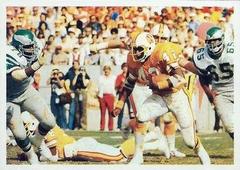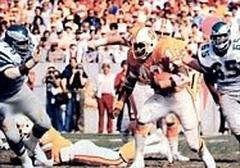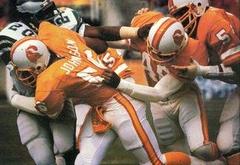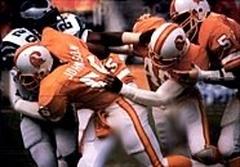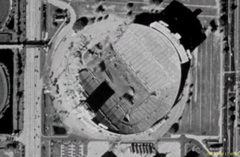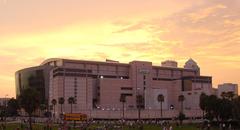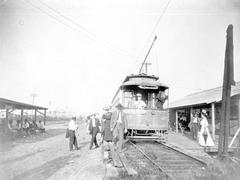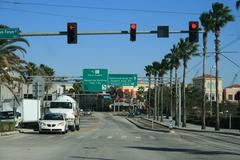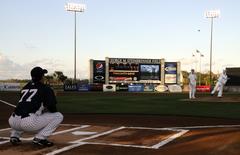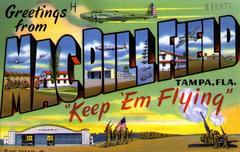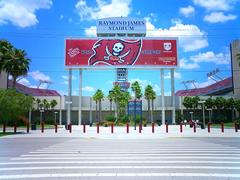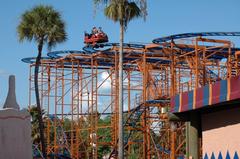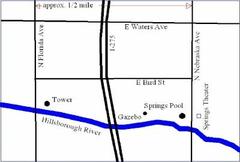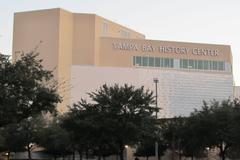
Tampa Stadium Visiting Hours, Tickets, and Historical Significance Guide
Date: 14/06/2025
Introduction: Tampa Stadium’s Legacy and Cultural Importance
Tampa Stadium, affectionately known as “The Big Sombrero,” is a storied landmark in Tampa, Florida’s sports and cultural landscape. Built in the mid-1960s and opened in 1967, the stadium was instrumental in positioning Tampa as a premier sports destination. It famously hosted the Tampa Bay Buccaneers from their inaugural 1976 season until 1997, as well as two Super Bowls—XVIII in 1984 and XXV in 1991. Beyond football, Tampa Stadium served as a stage for college sports, concerts, and pivotal community gatherings, making it a true civic hub (The Stadiums Guide; RetroSeasons).
While the original structure was demolished in 1999, its legacy endures at the site now occupied by Raymond James Stadium. Visitors today can explore the grounds, join guided tours at the current stadium, and delve into Tampa’s rich sporting history. This guide covers the stadium’s history, practical visiting information, ticketing, accessibility, travel tips, and the enduring cultural impact of both Tampa Stadium and its successor (Florida Visiting; Sportskeeda).
Whether you’re a sports enthusiast, history aficionado, or cultural explorer, this comprehensive resource equips you with everything needed to appreciate the spirit of “The Big Sombrero” and the modern Raymond James Stadium.
Table of Contents
- Tampa Stadium History
- Visiting Tampa Stadium Today
- Role in the Local Community
- Transition and Legacy
- Notable Features and Cultural Impact
- Timeline of Key Events
- Visitor Guide: Raymond James Stadium
- Frequently Asked Questions (FAQ)
- Conclusion & Call to Action
- References
Tampa Stadium History
Origins and Construction
Tampa Stadium was conceived as Tampa’s bid to become a sports capital. Construction began in 1966 next to Al Lopez Field, and the stadium opened in 1967 with an initial capacity of 46,000. Its first major event was an NFL preseason game in 1968. With the arrival of the Tampa Bay Buccaneers in 1976, expansions increased its capacity to over 74,000 by the late 1970s (The Stadiums Guide).
Architectural Significance
Notable for its sweeping, arch-shaped grandstands, Tampa Stadium’s design was both distinctive and functional. The open-bowl structure, constructed from concrete and aluminum bleachers, offered excellent sightlines but little shade—earning it the “Big Sombrero” nickname and a reputation for sweltering summer conditions (Football Stadium Digest).
Major Events and Tenants
- Tampa Bay Buccaneers: The stadium hosted the Buccaneers from their inception in 1976 until 1997, becoming synonymous with NFL football in Tampa (RetroSeasons).
- College Football & Other Sports: Home to the USF Bulls and site of high school championships, the Florida Classic, and the Hall of Fame/Outback Bowl (Florida Visiting).
- Super Bowls & National Events: Hosted Super Bowls XVIII and XXV, plus major concerts and community events (The Stadiums Guide).
Visiting Tampa Stadium Today
Location and Access
The original Tampa Stadium was demolished in 1999; its footprint now forms part of the parking and event staging areas for Raymond James Stadium at 4201 N Dale Mabry Hwy, Tampa, FL 33607 (Wikipedia).
- Access: The area is open to the public, with no formal visiting hours. The best time to visit is on non-event days for ease of parking and exploration.
- What Remains: The outline of the old stadium is visible as a grassy field and a circular road echoing its former perimeter.
Visiting Hours and Tours
- Raymond James Stadium: Open to visitors during events and scheduled tours. Guided tours, which sometimes include information on Tampa Stadium’s legacy, can be booked via the official website (Raymond James Stadium Tours).
- Tickets: Event tickets are available online or at the stadium box office (Raymond James Stadium Ticketing).
- Accessibility: Full ADA compliance, with accessible seating, restrooms, and parking (Raymond James Stadium Accessibility).
Role in the Local Community
Tampa Stadium served as a gathering space for local sports, charity events, and festivals, helping forge Tampa’s identity as a vibrant community and destination for sports tourism. Its presence spurred economic growth in the surrounding area, attracting hotels, restaurants, and other businesses catering to event-goers (Florida Visiting).
Transition and Legacy
By the 1990s, the stadium’s utilitarian design was outdated. The need for modern amenities led to the construction of Raymond James Stadium, which opened in 1998. The demolition of Tampa Stadium in 1999 marked the end of an era, but its spirit lives on in the new venue’s design and in the city’s enduring sports culture (Facts.net).
Notable Features and Cultural Impact
“The Big Sombrero” is remembered for its spirited atmosphere, unique architecture, and its role in hosting landmark events. The stadium’s nickname has become part of Tampa’s identity, and its influence is evident in Raymond James Stadium’s iconic pirate ship and community-focused design.
Timeline of Key Events
- 1966: Construction begins.
- 1967: Stadium opens.
- 1968: First NFL preseason game.
- 1976: Buccaneers’ inaugural season.
- 1979: Expansion to 74,000+ seats.
- 1984 & 1991: Hosts Super Bowls XVIII and XXV.
- 1997: Final Buccaneers game.
- 1998: Raymond James Stadium opens.
- 1999: Tampa Stadium demolished (The Stadiums Guide).
Visitor Guide: Raymond James Stadium
Tickets and Event Information
- Purchasing: Tickets for Buccaneers games, USF Bulls football, concerts, and other events can be purchased from the official ticket portal or authorized vendors.
- Entry: All tickets are mobile-only; download them in advance for quick entry (Mobile Ticketing Info).
Stadium Features and Amenities
- Seating: Lower Bowl (closest to the field), Club Level (premium experience), Upper Deck (budget-friendly), and luxury suites (Sportsnaut).
- Food: Tampa specialties, vegetarian, and gluten-free options (Raymond James Stadium Concessions).
- Team Store: Buccaneers, USF, and event merchandise (cashless transactions only).
Stadium Tours
- Experience: Field access, locker rooms, pirate ship, and more (Raymond James Stadium Tours).
- Booking: Advance online reservation required.
Parking and Transportation
- Event Parking: Official lots start at $30; pre-purchase is advised (Raymond James Stadium Parking).
- ADA Parking: Available close to entrances with placard.
- Rideshare/Public Transit: Designated zones and HART bus service (Raymond James Stadium).
Entry and Security
- Bag Policy: Only clear bags (12”x12”x6”) or small clutches (4.5”x6.5”) allowed (Stadium A-Z Guide).
- Food/Beverage: Outside food in clear bags or pizza boxes only; no outside drinks.
- Security: Metal detectors and bag checks at all entrances.
Accessibility
The stadium is fully ADA-compliant, with accessible seating, restrooms, and routes throughout (Raymond James Stadium Accessibility).
Tailgating and Pre-Game Experience
- Tailgating: Permitted in designated lots, opening three hours before kickoff. Pirate ship festivities and fan games are highlights.
Weather Tips
- Climate: Hot and humid; pack sunscreen, hats, lightweight clothing, and ponchos during rainy months. Umbrellas are not permitted.
Nearby Attractions
- Tampa Bay History Center: Chronicling Tampa’s past (Nomadasaurus).
- Ybor City: Historic district known for nightlife and dining (Nomadasaurus).
- Tampa Riverwalk: Scenic path along the river.
Accommodations
Recommended nearby hotels include Hilton Tampa Downtown, Le Méridien Tampa, and Tampa Marriott Waterside Hotel & Marina (Wanderlust Chloe).
Frequently Asked Questions (FAQ)
Q: Can I visit the original Tampa Stadium site?
A: Yes, the site is now part of Raymond James Stadium’s parking area and is accessible to the public.
Q: Are there tours that include Tampa Stadium history?
A: Some Raymond James Stadium tours highlight Tampa Stadium’s history.
Q: Where can I find Tampa Stadium memorabilia?
A: Local collectors, auctions, and occasionally the Buccaneers’ team store.
Q: What are the stadium’s visiting hours?
A: Gates open two hours before events; tours are by scheduled appointment.
Q: What is the bag policy?
A: Only clear bags (up to 12”x12”x6”) or small clutches (4.5”x6.5”) are allowed.
Q: Is Raymond James Stadium ADA-accessible?
A: Yes, with accessible seating, restrooms, and parking.
Conclusion & Call to Action
Tampa Stadium’s legacy as “The Big Sombrero” lives on through the vibrant sports culture of Tampa and the modern Raymond James Stadium. Whether you’re reliving sports history or enjoying today’s events, understanding the site’s past enriches your experience. For current updates on tours, events, and visitor tips, download the Audiala app and follow our channels for more on Tampa’s iconic venues.
References
- The Stadiums Guide
- Sportskeeda
- Wikipedia
- Sportsnaut
- RetroSeasons
- Florida Visiting
- Football Stadium Digest
- Facts.net
- Raymond James Stadium Tours
- Raymond James Stadium Accessibility
- Raymond James Stadium Ticketing
- Nomadasaurus
- Wanderlust Chloe
